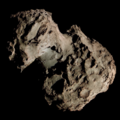Comet Quénisset, also known by its modern formal designation C/1911 S2, is a non-periodic comet that has a 4,000-year retrograde orbit around the Sun. It is the second of two comets discovered by French astronomer, Ferdinand Quénisset.[1]
Potential meteor shower
Orbital calculations by J. B. Dale revealed that although there would be no close encounter between the comet and the Earth, the former's descending node resulted in a minimum orbit intersection distance of about 0.0172 AU (2.57 million km) by 16 December 1911.[4] This has led to other scientists predicting a meteor shower originating from this comet that will be coming from the constellation Vulpecula on April 27 of each year, though none has been observed so far.[5]
References
- ^ a b M. M. Baldet; F. Quénisset (1911). "Découverte d'une Comète a l'Observatoire Flammarion de Juvisy" [Discovery of a Comet at the Flammarion Observatory in Juvisy]. L'Astronomie (in French). 25 (1): 436–437. Bibcode:1911LAstr..25..436B.
- ^ "Comet Names and Designations". International Comet Quarterly. Retrieved 20 December 2024.
- ^ "C/1911 S2 (Quénisset) – JPL Small-Body Database Lookup". ssd.jpl.nasa.gov. Jet Propulsion Laboratory. Retrieved 28 March 2024.
- ^ J. B. Dale (1911). "Elements of Comet 1911f" (PDF). Nature. 87 (2188): 450. doi:10.1038/087450b0.
- ^ M. Davidson (1920). "Council Cometary radiant points, 1875-1920" (PDF). Monthly Notices of the Royal Astronomical Society. 80 (8): 739–741. Bibcode:1920MNRAS..80..739D. doi:10.1093/mnras/80.8.739.
External links
- C/1911 S2 at the JPL Small-Body Database











You must be logged in to post a comment.